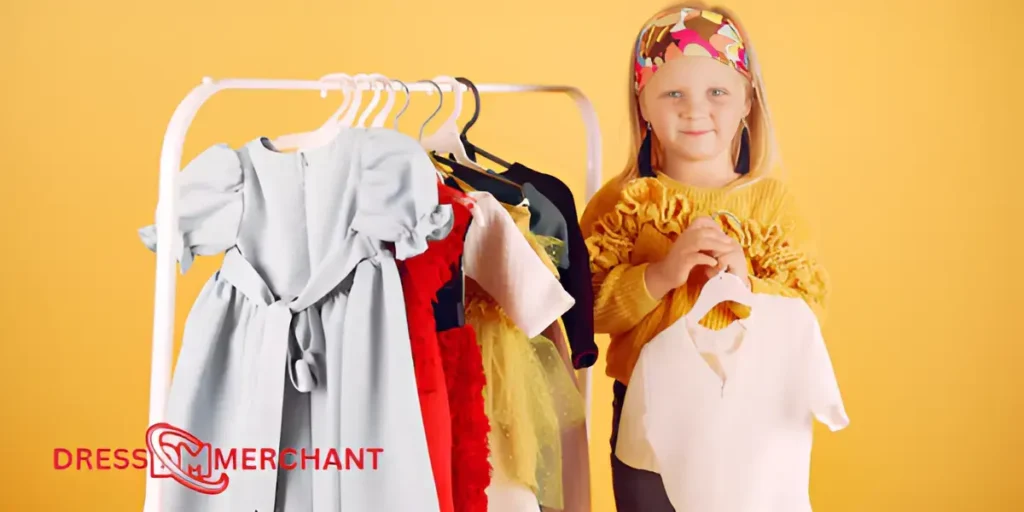As a leading Children Clothing Exporter Bangladesh, we offer high-quality, stylish, and durable clothing for kids. Our extensive range includes various designs and sizes to meet international market demands. With a focus on quality, comfort, and affordable pricing, we ensure that each piece is crafted with care. Choose us as your trusted Children Clothing Exporter Bangladesh for reliable and timely deliveries, ensuring your business stands out with premium kidswear.
Thank you for reading this post, don't forget to subscribe!
1. Introduction: The Growing Demand for Children’s Clothing from Bangladesh
Children’s clothing is one of the most dynamic and expanding markets within the global textile industry, with Bangladesh emerging as a key supplier in this thriving sector. Known for its unparalleled manufacturing capabilities, competitive pricing, and efficient supply chain, Bangladesh has firmly established itself as a preferred destination for sourcing children’s apparel.
The country’s history of textile production, combined with a large, skilled workforce and a commitment to quality, provides a competitive advantage to global businesses looking to import children’s garments.
Bangladesh is quickly gaining a reputation for producing children’s clothing that meets international standards, making it a top choice for buyers worldwide. The country’s apparel industry benefits from decades of experience in manufacturing high-quality garments, which has positioned it as a leading exporter. As the demand for children’s clothing increases due to population growth and evolving fashion trends, Bangladesh continues to meet these needs by adapting its manufacturing processes and maintaining cost-effective production.
1.1. Why Choose Bangladesh for Children’s Clothing Exports?
Bangladesh offers a unique set of advantages for companies looking to source children’s clothing. The country’s garment industry is well-established, with a robust infrastructure and an extensive network of garment manufacturers who specialize in children’s wear.
The apparel produced in Bangladesh caters to a diverse range of styles, from casual everyday wear to more formal outfits, ensuring a comprehensive selection for international buyers.
The major advantage of sourcing from Bangladesh is its ability to produce high-quality garments at affordable prices, making it a cost-effective choice for companies looking to remain competitive in the global market.
The proximity of Bangladesh to key shipping routes further enhances its appeal, offering fast and reliable shipping options to major international markets such as North America, Europe, and the Middle East. This combination of low manufacturing costs, high-quality output, and efficient logistics makes Bangladesh an attractive option for businesses seeking reliable suppliers.
1.2. A Brief Overview of the Children’s Clothing Industry in Bangladesh
The children’s clothing industry in Bangladesh has seen substantial growth in recent years, with the country’s garment sector becoming one of the leading producers of children’s apparel worldwide. Bangladesh excels in both mass production and custom clothing, offering flexibility for large-scale orders as well as personalized designs. From basic everyday clothes like t-shirts, dresses, and pants to sophisticated seasonal designs and special occasion outfits, Bangladesh caters to a wide range of children’s apparel demands.
A major driving force behind the success of the children’s clothing industry in Bangladesh is the country’s skilled workforce. Bangladesh is home to thousands of experienced textile workers, many of whom have specialized in producing garments for children.
This expertise, combined with the availability of modern machinery and materials, enables Bangladesh to maintain its competitive edge in the global marketplace.
Moreover, the country’s growing focus on sustainability and eco-friendly manufacturing practices aligns well with international trends toward more ethical production, further bolstering its reputation as a top supplier of children’s clothing.
2. The Benefits of Sourcing Children’s Clothing from Bangladesh
Choosing Bangladesh as a sourcing destination for children’s clothing comes with numerous advantages, making it an ideal choice for international businesses.
With its rapidly growing garment industry and commitment to producing high-quality products at competitive prices, Bangladesh stands out as a global leader in textile manufacturing.
2.1. Competitive Pricing and Cost-Effectiveness
Bangladesh offers a significant cost advantage, making it the preferred choice for companies looking to purchase high-quality clothing at affordable prices. The country’s low labor costs, favorable trade agreements, and efficient supply chains contribute to reduced production costs, ensuring that buyers get the best value for their investment.
Unlike many other garment-producing countries, Bangladesh’s operational costs remain remarkably low, which is a substantial benefit for businesses aiming to maximize profit margins.
Moreover, the government’s incentives and policies geared towards the garment sector further support cost-effective manufacturing, making Bangladesh an even more attractive destination for sourcing children’s clothing.
2.2. High-Quality Manufacturing and Compliance with International Standards
Bangladesh’s garment manufacturers adhere to stringent international quality standards. Many factories are certified by renowned quality control organizations, ensuring that the children’s clothing produced meets global expectations.
Whether it’s fabric durability, colorfastness, or safety compliance, Bangladeshi manufacturers pay meticulous attention to detail in their production processes.
The strict regulations set by global organizations like the International Labour Organization (ILO) and the Global Organic Textile Standard (GOTS) ensure that clothing produced in Bangladesh meets high ethical and environmental standards. This compliance ensures that businesses and customers alike can trust the safety and quality of the products they are purchasing.
Additionally, many manufacturers in Bangladesh invest in cutting-edge technology and use high-quality raw materials to guarantee the end product’s longevity and performance.
2.3. Diverse Product Range
From everyday outfits to seasonal collections, Bangladesh is capable of producing a wide range of children’s clothing. These include t-shirts, dresses, pants, skirts, pajamas, and outerwear, among others.
This versatility makes Bangladesh an excellent choice for companies needing a broad selection of children’s apparel to cater to diverse market needs. With the ability to handle both mass production and specialized small-batch orders, Bangladesh’s garment industry is flexible enough to meet the varying demands of different retailers, both large and small.
Whether businesses are looking to create trendy designs or classic staples, Bangladeshi manufacturers can offer the customization options and extensive fabric varieties needed to suit every collection.
The country’s wide-ranging garment production capabilities further establish its status as a hub for children’s apparel sourcing.
3. The Supply Chain Efficiency of Bangladesh’s Children’s Clothing Industry
A well-organized supply chain is crucial for timely delivery and the ability to meet international demands. Bangladesh’s children’s clothing export sector benefits from a robust supply chain, which serves as a significant selling point for global buyers. The country’s ability to manufacture, ship, and deliver products efficiently makes it a leading player in the international clothing market.
3.1. Streamlined Production Processes
Bangladesh boasts a well-established system for garment manufacturing, with a robust infrastructure that ensures streamlined production processes. The country is home to advanced machinery, skilled labor, and decades of experience in textile production.
This combination allows exporters to meet tight deadlines while maintaining high standards of quality. Factories are equipped with the latest technologies to improve production speed and reduce errors, which results in cost-effective operations.
Furthermore, Bangladesh’s garment industry is known for its flexibility, as manufacturers can quickly adapt to changing trends or bulk orders, ensuring global buyers have access to the latest styles in children’s apparel.
With skilled workers across various sectors of the garment industry, from design to finishing, Bangladesh can maintain consistency in production. The skilled workforce is essential for maintaining quality control throughout each stage of manufacturing, ensuring the products meet global quality standards.
3.2. Effective Shipping and Logistics
Bangladesh’s strategic location on the Bay of Bengal plays a key role in its supply chain success. The country’s ports, particularly the Port of Chittagong, are among the busiest in the region, allowing for quick and efficient transportation of goods.
The infrastructure surrounding these ports ensures that Bangladesh remains a hub for global exports, making it easier for international buyers to access products in a timely manner. With direct access to shipping routes that connect Asia, Europe, and North America, Bangladesh is able to reduce lead times significantly.
In addition to sea freight, Bangladesh also has access to robust air cargo systems, providing businesses with further options for faster deliveries. For time-sensitive orders, air freight allows products to reach global markets in record time, improving flexibility for international buyers.
3.3. Transparency in the Supply Chain
Transparency is essential when sourcing products internationally, and Bangladesh excels in providing clear communication throughout the supply chain. Buyers are given the ability to track the production process from start to finish.
This transparency not only ensures that orders are completed on time, but also assures international buyers that their products meet their specifications.
Bangladesh has implemented systems that allow real-time updates on orders, helping businesses stay informed throughout the manufacturing and shipping stages.
This level of transparency builds trust between suppliers and buyers and is vital for maintaining long-term business relationships. In an increasingly competitive global market, transparency serves as an invaluable asset, fostering accountability and enabling businesses to make informed decisions.
4. Sustainable Practices in Children’s Clothing Manufacturing
With the growing demand for eco-friendly products, sustainability has emerged as a top priority in the global textile industry. Bangladesh, a key player in the garment manufacturing sector, has increasingly embraced sustainable practices, particularly in children’s clothing.
These innovations not only meet market demand but also help the country compete in a global market that is becoming ever more focused on environmental consciousness.
4.1. Use of Eco-Friendly Materials
In recent years, Bangladesh has made significant strides toward adopting sustainable raw materials in its children’s clothing lines. Manufacturers are now incorporating a variety of eco-friendly fabrics like organic cotton, bamboo, and hemp into their products. Organic cotton, in particular, has become a preferred material due to its natural farming methods that avoid harmful pesticides and synthetic fertilizers. Bamboo fabrics are also gaining popularity as they are biodegradable and require fewer resources to grow. The use of these eco-conscious materials results in clothing that is not only soft and breathable but also reduces the overall environmental impact of textile production.
As global consumer preferences shift toward sustainable fashion, Bangladesh’s commitment to using these materials helps strengthen its position in the eco-friendly fashion market.
4.2. Waste Reduction and Recycling Initiatives
A significant step toward sustainability is the active waste reduction and recycling initiatives being implemented by manufacturers in Bangladesh. Factories are adopting new technologies to minimize textile waste generated during production.
Leftover fabric scraps are no longer discarded but instead repurposed into new products or used for secondary applications. For instance, offcuts might be turned into accessories, packaging materials, or even upcycled into new fabric blends.
This level of waste minimization ensures that fewer raw materials are needed, reducing both resource consumption and landfill waste. Furthermore, manufacturers are increasingly investing in recycling programs to handle post-consumer waste, thus creating a circular economy in the garment sector.
These practices resonate with international buyers, particularly those focused on reducing their environmental footprint.
4.3. Energy-Efficient Production Methods
Another key component of Bangladesh’s sustainable manufacturing practices is the adoption of energy-efficient production methods. Many garment factories are turning to renewable energy sources, such as solar power, to run their operations.
The shift towards green energy not only reduces carbon emissions but also lowers overall energy costs for manufacturers. In addition, energy-saving equipment like efficient lighting, automated systems, and optimized machinery are being used to decrease energy consumption.
These energy-efficient practices are crucial to making children’s clothing production more sustainable and cost-effective. As the global market continues to prioritize sustainability, these eco-friendly production methods help solidify Bangladesh’s reputation as a responsible and forward-thinking supplier of children’s apparel.
5. Understanding the Quality Standards for Children’s Clothing
When sourcing children’s clothing, ensuring the highest standards of quality is non-negotiable. Parents and retailers alike expect these garments to be not only visually appealing but also safe, durable, and comfortable for children.
Bangladesh’s garment manufacturers are deeply committed to delivering children’s clothing that meets or exceeds international quality standards. The country’s strong manufacturing infrastructure and skilled workforce play a crucial role in producing apparel that conforms to global requirements, creating products that satisfy the most discerning buyers and consumers.
5.1. Safety Standards for Children’s Garments
Safety is the paramount concern when designing and manufacturing children’s clothing. Given the vulnerability of young children, it is critical that their clothing is free from any hazards. Bangladesh’s garment manufacturers strictly comply with international safety regulations related to the use of non-toxic dyes, fabrics, and materials.
They carefully follow flammability regulations, ensuring that children’s clothing does not catch fire easily. Furthermore, clothing with small parts, such as buttons or decorative elements, must meet rigorous standards to avoid posing choking hazards.
These manufacturers take extra care in sourcing materials that are hypoallergenic and free from harmful chemicals, in line with global regulatory bodies’ standards. As a result, parents can trust that the clothing exported from Bangladesh is not only fashionable but also safe for children to wear.
5.2. Durability and Comfort
Children’s clothing must be designed with an understanding of the demanding nature of daily life. These garments are put through rigorous use, from outdoor activities to playtime, and are frequently subjected to washing.
As such, durability and comfort are essential qualities in children’s apparel. Bangladesh’s manufacturers take these factors into account by using high-quality stitching techniques and selecting fabrics that withstand frequent washing and wear. Additionally, they pay close attention to the finishes applied to garments, ensuring that zippers, seams, and buttons remain intact even after multiple uses.
Comfort is also a top priority, and garments are carefully designed to ensure a soft, breathable fit for children, allowing them to move freely and comfortably throughout the day.
5.3. Testing and Certification
To ensure that children’s clothing complies with international standards, manufacturers in Bangladesh conduct comprehensive testing throughout the production process.
This includes testing the strength of fabrics, color retention after washing, and overall garment performance. Many manufacturers go the extra mile by obtaining certifications from renowned international organizations such as OEKO-TEX, which certifies that the clothing is free from harmful chemicals, ensuring it is safe for young wearers.
These certifications not only demonstrate a commitment to safety and quality but also enhance the global competitiveness of Bangladesh’s children’s clothing industry.
The rigorous testing processes ensure that each product delivers on its promise of durability, safety, and comfort, making Bangladesh a trusted supplier for international children’s clothing markets.
6. The Role of Technology in Children’s Clothing Manufacturing
Technology plays a vital role in improving the efficiency and quality of children’s clothing production in Bangladesh. From design to manufacturing and logistics, the integration of advanced technology has revolutionized the country’s garment sector.
Manufacturers in Bangladesh have increasingly adopted digital tools, automation, and AI-driven solutions to boost productivity, streamline operations, and ensure high-quality products.
The continued use of these technologies has positioned Bangladesh as a key player in the global children’s clothing market.
6.1. Digital Design and Prototyping
Advanced digital tools and software are used for design and prototyping in Bangladesh’s children’s clothing sector. These tools allow for faster production times, better accuracy in measurements, and the ability to make adjustments to designs in real time.
Digital design technology also aids in creating customized patterns and prints, catering to diverse consumer preferences. Software like CAD (Computer-Aided Design) enables designers to create detailed and precise visualizations of their designs, reducing the risk of errors before physical production begins.
Additionally, 3D modeling software helps manufacturers visualize the end product, ensuring that the designs are both aesthetically appealing and functional for young wearers. This has drastically cut down on prototyping time, ensuring that children’s clothing manufacturers can bring products to market more quickly, allowing for faster response to trends and consumer demands.
6.2. Automated Manufacturing Processes
Automation has become a game-changer in the garment manufacturing industry. In Bangladesh, manufacturers use automated machines for tasks such as cutting, stitching, and finishing, which increases efficiency and reduces human error.
These automated processes also contribute to maintaining consistent product quality and meeting large-scale production demands. With the help of automated cutting machines, manufacturers can ensure that fabric is cut with extreme precision, reducing material waste and lowering costs.
Automated sewing machines also help streamline stitching processes, making production faster and more consistent, while minimizing the potential for mistakes. This level of automation is particularly beneficial in children’s clothing production, where attention to detail, comfort, and safety are paramount.
Furthermore, automation allows manufacturers to produce large volumes of clothing in a shorter period, which is crucial for meeting the global demand for children’s apparel.
6.3. AI and Data Analytics in Supply Chain Management
Artificial intelligence (AI) and data analytics are being increasingly integrated into Bangladesh’s garment manufacturing sector. AI-driven tools help optimize supply chain management, predict trends, and ensure that production schedules are met without delays. These innovations allow manufacturers to stay ahead of market demand and provide timely deliveries to their clients.
By using AI to forecast trends, manufacturers can predict what colors, designs, and styles will be popular in the upcoming seasons, reducing the risks associated with overproduction or underproduction.
Additionally, data analytics enable manufacturers to track and manage inventory more efficiently, ensuring that they can meet consumer demand while avoiding excess stock. This level of insight into the supply chain helps optimize production schedules, reduce lead times, and increase overall operational efficiency.
Moreover, data analytics can be used to identify potential bottlenecks in the production process, allowing manufacturers to address issues before they cause delays, further improving the overall efficiency of children’s clothing production.
7. Ethical Manufacturing in Bangladesh’s Children’s Clothing Industry
Ethical practices in garment production are essential for ensuring fair labor standards and promoting a positive corporate image. Bangladesh, as one of the leading exporters of children’s clothing, has been making significant strides in ensuring ethical manufacturing practices within the children’s clothing sector.
These initiatives not only ensure the production of high-quality products but also improve the lives of workers, which in turn boosts the reputation of manufacturers in the global market.
7.1. Fair Labor Practices
Fair labor practices are crucial for any industry, especially for children’s clothing, as it involves sensitive ethical considerations. Many Bangladeshi garment manufacturers comply with international labor laws and fair wage standards. These factories ensure that workers are paid justly and on time for their contributions.
In addition to fair wages, these manufacturers adhere to child labor laws, ensuring that no children are involved in the production processes. The government of Bangladesh has implemented labor reforms, pushing the sector toward more ethical practices.
With global brands and buyers putting pressure on their suppliers, these regulations are increasingly followed, ensuring that the children’s clothing produced in Bangladesh is ethically manufactured.
7.2. Worker Safety and Welfare
The safety and welfare of workers are increasingly becoming top priorities in Bangladesh’s garment industry, particularly in the children’s clothing sector, which requires a high level of care and attention to detail.
Many factories are now equipped with state-of-the-art safety measures, including fire safety protocols, protective gear, and safety training for workers. Factories ensure that their employees work in safe, clean, and well-lit environments.
Furthermore, workers are provided with essential benefits such as healthcare, paid leave, and social security. Regular inspections are conducted to ensure that safety standards are met and maintained. Additionally, some companies have introduced wellness programs and on-site facilities for employees, ensuring their physical and mental well-being.
7.3. Commitment to Corporate Social Responsibility (CSR)
Corporate Social Responsibility (CSR) initiatives have gained significant traction within Bangladesh’s children’s clothing sector. Many manufacturers are adopting CSR practices that go beyond the legal requirements and contribute to social welfare.
These initiatives include community development programs, educational support for workers’ children, and contributions to environmental sustainability. Some companies invest in renewable energy sources, waste reduction practices, and water conservation initiatives to minimize their ecological footprint.
CSR practices also include working with NGOs to enhance worker rights and welfare. These initiatives not only help manufacturers build stronger relationships with international buyers but also foster a positive reputation in the global market, ensuring long-term growth and success.
By aligning with global CSR standards, Bangladesh’s children’s clothing sector is demonstrating a commitment to sustainability and ethical production.
8. How to Choose the Right Children’s Clothing Exporter in Bangladesh
Selecting the right exporter is key to ensuring that your business receives high-quality children’s clothing that meets your specific requirements. Several factors should be considered when choosing a supplier in Bangladesh.
8.1. Evaluate the Supplier’s Reputation and Experience
Look for exporters who have a proven track record in the industry and a reputation for delivering high-quality products. Researching client testimonials, reviewing case studies, and checking certifications can help you assess the reliability of potential suppliers.
A reputable exporter should have strong industry experience and a history of fulfilling orders for global clients. It’s also beneficial to check their export records, ensuring they comply with international trade standards and regulations. You can also inquire about the suppliers’ relationships with their other customers to get an idea of their professionalism and reliability.
In addition to that, always check if the exporter has any industry-specific certifications that demonstrate their commitment to quality and ethical practices. For instance, certifications like ISO 9001 or BSCI (Business Social Compliance Initiative) may be indicators of their commitment to upholding international quality standards.
8.2. Assess the Product Range and Customization Options
Different buyers have different needs when it comes to children’s clothing. It’s important to choose an exporter who can provide a wide range of products and customization options, allowing you to meet the specific demands of your market.
Some buyers might need basic children’s wear, while others may require special garments like organic or eco-friendly clothing. A capable exporter should offer flexibility in terms of fabric, design, sizing, and production time.
Customization options are also important for differentiating your brand in the competitive market. Ensure that the supplier can incorporate unique designs, logos, or other branding elements. Assess the exporter’s capacity to handle bulk orders with a quick turnaround time, as this will impact your ability to meet market demands efficiently.
If you are targeting specific customer segments, like high-end boutique stores or budget-conscious consumers, choosing an exporter who understands these distinctions can help.
8.3. Ensure Timely Delivery and Customer Service
Efficiency and customer service are key when dealing with international orders. Ensure that the exporter you choose has a reliable system for fulfilling orders on time and is responsive to any inquiries or concerns. Late deliveries can lead to stock shortages and missed sales opportunities, which could harm your business’s reputation.
Additionally, ensure the exporter provides clear and transparent communication channels. In case of any issues with the order, such as delays or product discrepancies, they should have an effective customer service team that can address your concerns promptly. Communication is vital, especially when dealing with long-distance shipments, and it’s essential to have a responsive partner who keeps you informed about the status of your order.
9. Conclusion: Children Clothing Exporter Bangladesh
Bangladesh has firmly established itself as a global leader in children’s clothing exports, offering a compelling mix of quality, affordability, reliability, and ethical manufacturing practices. The country’s focus on sustainability, technological innovation, and supply chain efficiency ensures that international buyers receive not just products, but value-driven solutions tailored to their needs.
From diverse product ranges to strict adherence to safety and quality standards, Bangladesh’s children’s clothing manufacturers are fully equipped to meet the evolving demands of the global market. Whether you are a small retailer or a large apparel brand, sourcing from Bangladesh means gaining a trusted partner committed to helping your business succeed.
As global trends continue to emphasize eco-consciousness, ethical sourcing, and superior craftsmanship, partnering with a children’s clothing exporter from Bangladesh is not just a smart business decision — it’s an investment in a sustainable and prosperous future for your brand.
Choose Bangladesh for your children’s clothing needs — where craftsmanship meets care, and innovation meets tradition.













